The 2011 Mid-Range SSD Roundup: 120GB Agility 3, Intel 510 and More Compared
by Anand Lal Shimpi on June 7, 2011 12:52 PM ESTAnandTech Storage Bench 2011
I didn't expect to have to debut this so soon, but I've been working on updated benchmarks for 2011. Last year we introduced our AnandTech Storage Bench, a suite of benchmarks that took traces of real OS/application usage and played them back in a repeatable manner. I assembled the traces myself out of frustration with the majority of what we have today in terms of SSD benchmarks.
Although the AnandTech Storage Bench tests did a good job of characterizing SSD performance, they weren't stressful enough. All of the tests performed less than 10GB of reads/writes and typically involved only 4GB of writes specifically. That's not even enough exceed the spare area on most SSDs. Most canned SSD benchmarks don't even come close to writing a single gigabyte of data, but that doesn't mean that simply writing 4GB is acceptable.
Originally I kept the benchmarks short enough that they wouldn't be a burden to run (~30 minutes) but long enough that they were representative of what a power user might do with their system.
Not too long ago I tweeted that I had created what I referred to as the Mother of All SSD Benchmarks (MOASB). Rather than only writing 4GB of data to the drive, this benchmark writes 106.32GB. It's the load you'd put on a drive after nearly two weeks of constant usage. And it takes a *long* time to run.
I'll be sharing the full details of the benchmark in some upcoming SSD articles but here are some details:
1) The MOASB, officially called AnandTech Storage Bench 2011 - Heavy Workload, mainly focuses on the times when your I/O activity is the highest. There is a lot of downloading and application installing that happens during the course of this test. My thinking was that it's during application installs, file copies, downloading and multitasking with all of this that you can really notice performance differences between drives.
2) I tried to cover as many bases as possible with the software I incorporated into this test. There's a lot of photo editing in Photoshop, HTML editing in Dreamweaver, web browsing, game playing/level loading (Starcraft II & WoW are both a part of the test) as well as general use stuff (application installing, virus scanning). I included a large amount of email downloading, document creation and editing as well. To top it all off I even use Visual Studio 2008 to build Chromium during the test.
Update: As promised, some more details about our Heavy Workload for 2011.
The test has 2,168,893 read operations and 1,783,447 write operations. The IO breakdown is as follows:
| AnandTech Storage Bench 2011 - Heavy Workload IO Breakdown | ||||
| IO Size | % of Total | |||
| 4KB | 28% | |||
| 16KB | 10% | |||
| 32KB | 10% | |||
| 64KB | 4% | |||
Only 42% of all operations are sequential, the rest range from pseudo to fully random (with most falling in the pseudo-random category). Average queue depth is 4.625 IOs, with 59% of operations taking place in an IO queue of 1.
Many of you have asked for a better way to really characterize performance. Simply looking at IOPS doesn't really say much. As a result I'm going to be presenting Storage Bench 2011 data in a slightly different way. We'll have performance represented as Average MB/s, with higher numbers being better. At the same time I'll be reporting how long the SSD was busy while running this test. These disk busy graphs will show you exactly how much time was shaved off by using a faster drive vs. a slower one during the course of this test. Finally, I will also break out performance into reads, writes and combined. The reason I do this is to help balance out the fact that this test is unusually write intensive, which can often hide the benefits of a drive with good read performance.
There's also a new light workload for 2011. This is a far more reasonable, typical every day use case benchmark. Lots of web browsing, photo editing (but with a greater focus on photo consumption), video playback as well as some application installs and gaming. This test isn't nearly as write intensive as the MOASB but it's still multiple times more write intensive than what we were running last year.
As always I don't believe that these two benchmarks alone are enough to characterize the performance of a drive, but hopefully along with the rest of our tests they will help provide a better idea.
The testbed for Storage Bench 2011 has changed as well. We're now using a Sandy Bridge platform with full 6Gbps support for these tests. All of the older tests are still run on our X58 platform.
AnandTech Storage Bench 2011 - Heavy Workload
We'll start out by looking at average data rate throughout our new heavy workload test:
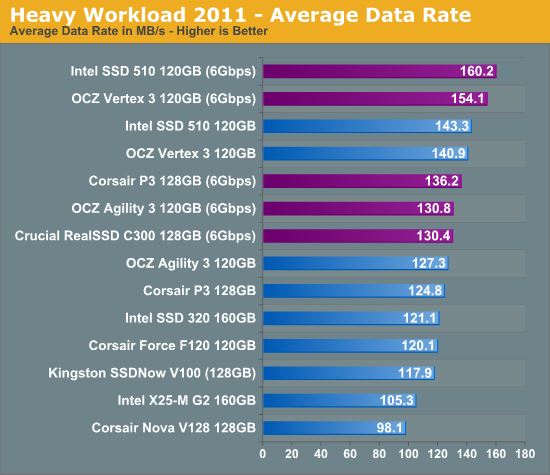
What SandForce has done with the SF-2281 controller is very impressive when you look at these results. Keep in mind that our Heavy Workload is the most write-heavy of our new benchmarks and it uses a lot of data that's already compressed (images, videos, file archives). Despite the makeup of the workload, the SF-2281 based Vertex 3 is nearly the fastest drive here - outpacing both the P3 and C300. The Agility 3, with its asynchronous NAND isn't quite as strong and is actually outpaced by Corsair's P3.
Intel's 160GB SSD 320 is a 3Gbps SATA drive and thus it can't compete with the 6Gbps offerings near the top. If we only look at 3Gbps results however, the standings aren't all that impressive. The 320, P3 and Agility 3 all fall within the same performance group, with the Vertex 3 clearly pulling ahead.
There's another drive from Intel however that does manage to impress: the Intel SSD 510. At 250GB, the 510 isn't competitive with OCZ's 240GB Vertex 3 however at 120GB the tests tell a different story. OCZ loses the ability to interleave reads/writes on a per device basis and thus takes a pretty significant performance hit. It's likely all of the incompressible data in this workload that really forces a difference between the 240GB and 120GB Vertex 3s. The 510 however doesn't have that problem, and the 120GB drive actually outperforms the Vertex 3 here. Not to mention that it should be more reliable if history is any indication.
The breakdown of reads vs. writes tells us more of what's going on:
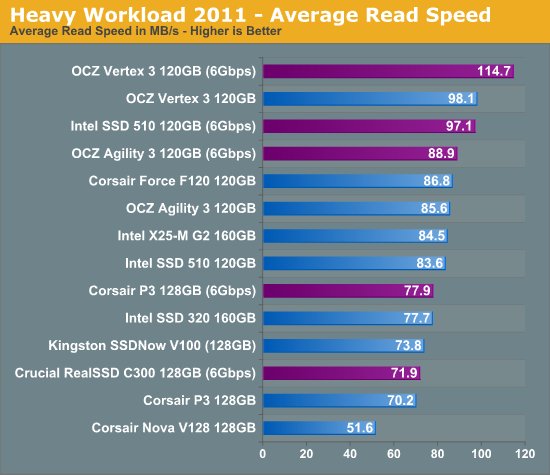
Read performance is where the Vertex 3 really makes up most of its advantage. At 114.7MB/s the Vertex 3 is nearly 30% faster than the Agility 3 here. Write speed however is a closer race between all of the drives:
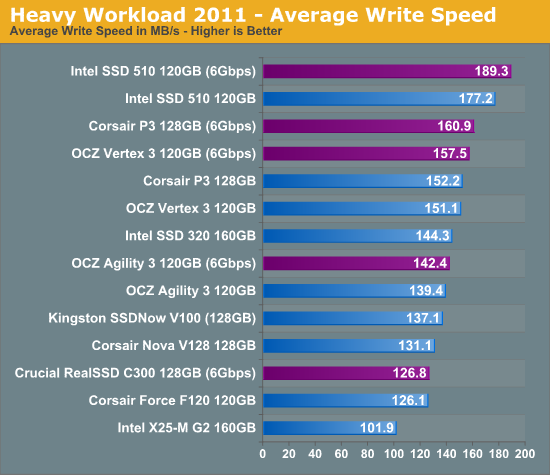
The next three charts just represent the same data, but in a different manner. Instead of looking at average data rate, we're looking at how long the disk was busy for during this entire test. Note that disk busy time excludes any and all idles, this is just how long the SSD was busy doing something:
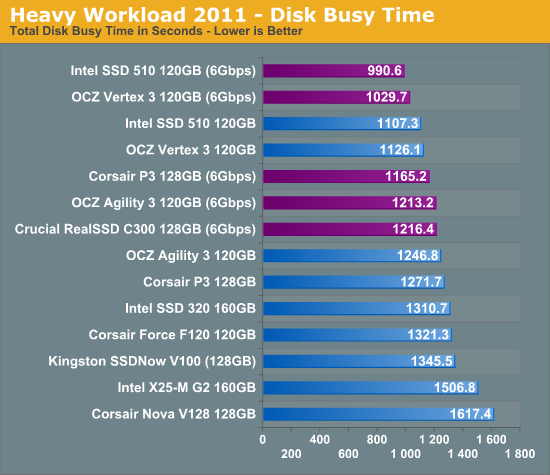
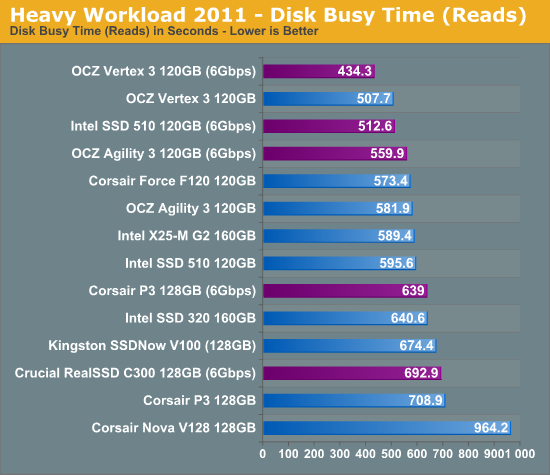
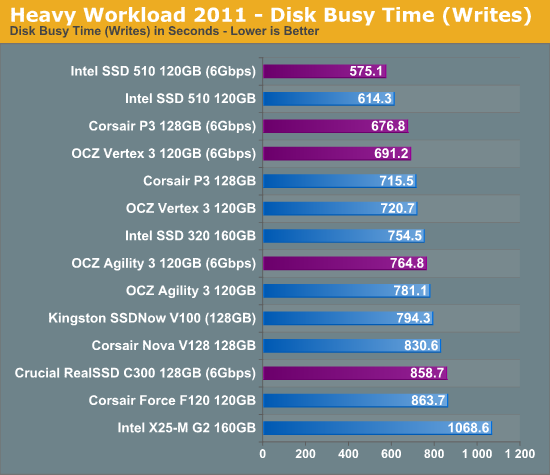










68 Comments
View All Comments
GrizzledYoungMan - Tuesday, June 7, 2011 - link
Just found this: http://www.overclock.net/ssd/956371-whats-best-sat...Basically answers my question right there, haha.
howelk - Wednesday, June 8, 2011 - link
I'm pondering purchase of Crucial m4-256, Intel 510, Samsung 470, or Intel 320 300GB.. system is 790GX/Phenom II 965. I'm interested in mostly hosting a bunch of VM's for home lab.kuzzia - Wednesday, June 8, 2011 - link
Thank you, thank you for also reviewing mainstream SSD's instead of the usual 240 GB. After all, not many people can afford those after all. But wonder why Intel chose to include the 160 GB instead of the 120 GB. Too afraid to show weaknesses of 120 GB?Dribble - Wednesday, June 8, 2011 - link
The 128GB version of that is probably the most popular new drive out there right now being as it's fast but significantly cheaper then the vertex 3 and the Intel 510.KenPC - Wednesday, June 8, 2011 - link
Anand,In previous articles you have very clearly shown that a sandforce sata II drive can write at no more than about 85MB/s. A sandforce sata III drive was about 135 to 150Mb;/s as I recollect.
Any reported value above these numbers is due to compression and caching within the drive controller.
This limitation becomes most clear when truly incompressible files, such as video clips, are used.
First, I question any write speed above these values that claim to be with 'incompressible' data. Even you raised a flag about this in previous articles. Read speeds may also be affected in somewhat the same way.
Sandforce controllers are clever, but you mileage may vary widely. Most benchmark tests are highly affected by the drive controller compression and caching.
Second, if compression and caching are a good thing, why not use the OS to compress and cache? In this case, the SATA bus could no longer be a bottle neck, and speeds that far exceed the SATA II or III specs are available. In this way, everyone can have the effects of a sandforce controller, except perhaps better.
For those interested in trying with a SSD drive, check 'compress this drive to save space' in W7. Then rerun the atto benchmark. I found overwhelming improvement in data transfer rates that far exceeded the sata II/III bus capability.
krazyderek - Wednesday, June 8, 2011 - link
would have loved to see a nice summary of how all the drives perform after being "abused" and trimmed, i remember that some of these drives don't handle it so well..... the c300? really would have liked to see that part of the overall comparison, especially since i'm guessing degraded performance happens to the smaller drives easier.geok1ng - Wednesday, June 8, 2011 - link
I believe that the Intel 320 series still packs a punch, given the cheaper price tag and hardware features absent from the 510 like data encription or absent from all the other consumer SSDs, like an array of caps to prevent data loss from poqer failures. Tha is an aspect of the 320 series that the round up has failed to point out.Between Intel 320 and 510 series the user trades performance for price and reliability. And Intel strategy today is to explaim to people that while there is a huge real world gap between HDD and the slowest SSD of this generation, te real worlds benefits of choosing the fastest SSD today and the slowest are dim to non-existant.
Bigu - Wednesday, June 8, 2011 - link
It's interesting to see that between Intel 510 250GB and 120GB, the smaller drive performs much better in random writes. (from this chart http://www.anandtech.com/show/4244/intel-ssd-320-r...In fact, generally, the gap between these two are smaller than that between 320 300GB and 160GB, as well as OCZ V3 240GB and 120GB.
Fallen Kell - Wednesday, June 8, 2011 - link
This is exactly the kind of comparison I had been looking for, and timing couldn't have been more perfect (I only started looking for this comparison 4 hours AFTER you had posted it). It made my decision pretty easy. I went with the Intel SSD 510 120GB. With the issues that are occurring on all the Sandforce 2200-2500 controllers, I ruled them out (Corsair just recalled all of their drives.... I suspect that others will have to do the same). And the performance really isn't that much worse in general. While I considered the C300, the very small reserved area is what lead me to remove it from my list. So that only left the 2 Intel drives, and given the fact that the 510 performed better and was cheaper (with less disk space), it was the right choice for me.ArtShapiro - Wednesday, June 8, 2011 - link
I too want to extend my appreciation for an informative and understandable article!Am I the only one who has been afraid to jump into the SSD camp due to concerns about reliability? I'm backed up by Windows Home Server daily on all my machines, but the thought of getting bricked is still unpleasant. Yeah, magnetic drives eventually fail, but not very often.
I wonder if this new Z68 caching facility offers the optimal solution - pretty darned fast, a nice improvement over a straight magnetic system, and (I assume) no grievous hardship if the SSD starts pining for the fjords.
Art